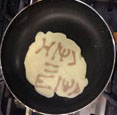Seminar "Correlations in SU(N) Fermi-Hubbard models" Dr. Mathias Mikkelsen, Kindai University, Osaka

Description
Speaker
Mathias Mikkelsen
Postdoctoral Researcher
Kindai University, Osaka
Abstract
The realization of SU(N) Hubbard models experimentally using Alkaline-earth atoms in optical lattices [1] has led to renewed theoretical interest in this model, see e.gs. [2,3]. More recent experiments [4] have succeeded in lowering temperatures of the system down to 0.1 times the tunneling amplitude, at which point observing correlations associated with ground-state properties starts to become feasible. In this talk I will introduce two projects related to investigating the correlation properties of SU(N) Fermi-Hubbard models, whose properties depends on the interaction strength U and the hopping strength J.
The first is relevant for experimental measurements of longer-range spin order which is expected to be observable [5] at temperatures reached in [4]. It is well-established that the noise correlations in the momentum distribution, which can be measured by time-of-flight experiments, are closely related to the spin structure factor in the Mott-limit of SU(2)-Hubbard models [6]. In our work [7] we explicitly establish the mathematical relationship between the momentum noise correlations and the spin structure factor for Mott-states in the SU(N)-Hubbard model at any integer filling. The relation is confirmed numerically by DMRG calculations for 1D Fermi-Hubbard (FHM) models at N=2-6. Numeric and semi-analytic arguments suggest that the error in the spin-structure factor obtained from our formula for finite U/J, at realistic lattice sizes and values of U/J, is inversely proportional to (J/U)^2.
The second project is concerned with the dynamic spread of initially localized excitations after a quench from a Mott-state to finite U/J. In locally interacting lattice models the spatial spread of correlations is bounded by a lightcone [8,9]. For the Bose-Hubbard model detailed theoretical studies [9] and experimental evidence [10] of this has been obtained, but there are no studies on the FHM. For large U/J the physics of the BHM is well-described in terms of quasi-particle excitations on top of the Mott-medium leading to bosonic enhancement of the velocity v=6 Ja/hbar (where a is the lattice spacing and hbar the reduced Planck constant), compared with v=4 Ja/hbar for small U where this picture breaks down. The velocity can be numerically accessed through the density-density correlations, which we obtain for SU(N) FH models (N=2-4) by the time-evolving block decimation method. While the SU(2) case is bounded by v=4Ja/hbar , N>2 can lead to collective enhancement, which based on simple arguments likely lead to v=6Ja/hbar in the limit of large N. We show that this enhancement is highly dependent on the presence of specific superpositions in the initial state resulting in relatively large entanglement entropy, and is not observed for a simple product state.
[1] S. Taie et al., Nature Physics 8, 825 (2012).
[2] A.V. Gorshkov et al., Nature Physics 6, 289–295 (2010)
[3] S. Capponi, P. Lecheminant and K. Totsuka, Ann.Phys. 367, 50 (2016)
[4] S. Taie et al., Nat. Phys. 18, 1356 (2022).
[5] L. Bonnes et al. Phys. Rev. Lett. 109, 205305 (2012).
[6] E. Altman, E. Demler, and M. D. Lukin, Phys. Rev. A 70, 013603 (2004)
[7] M. Mikkelsen and I. Danshita, Phys. Rev. A 107, 043313 (2023)
[8] Z. Wang and K. R.A. Hazzard, PRX Quantum 1, 010303 (2020)
[9] M. Cheneau et al., Nature 481, 484–487 (2012)
[10] P. Barmettler, D. Poletti, M. Cheneau and C. Kollath, Phys.Rev. A 85, 053625 (2012)
Looking forward to seeing many of you at the seminar.
-Quantum Systems Unit / Busch Unit
Add Event to My Calendar
Subscribe to the OIST Calendar
See OIST events in your calendar app





